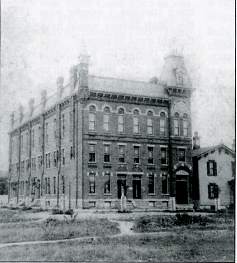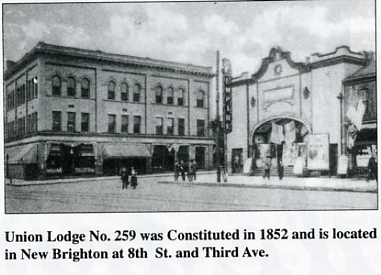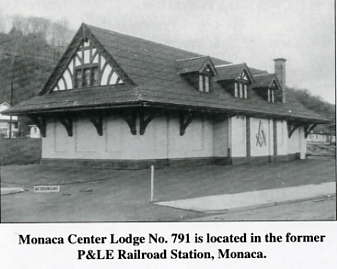
Rochester Lodge No. 229 is the oldest
Masonic lodge in Beaver County.
Click Here to Return to Milestones

Masonic history in Beaver County began prior
to Revolutionary times. The Fall 2004 Milestones feature story,
"The History of Crow's Run" and its reference to John
McKee inspired this narrative on the subject of Free Masonry.
The fall feature on Crow's Run written by Joseph H. Thompson,
has McKee as the grantee of 800 acres in New Sewickley for his
services in the Revolutionary War. It further references McKee
as "being one of the Indians" at the Boston Tea Party.
The 170 year old tombstone I observed in Oak Grove Cemetery supports
the author's implication. It was the work of his own family's
hands done by J. W. Thompson. It is alongside the road at the
soldiers monument and still in good condition.
The "Indians" or Sons of Liberty dressed as Mohawks
at Boston Harbor were the members of St. Andrews Masonic Lodge
led by Brother Paul Revere. The "raid" was signaled
to begin after a stirring oration by Brother Samuel Adams. One
could believe therefore that John McKee was also a Brother (Bro.)
of the Craft or at least had Masonic connections during the Revolutionary
War and later in Beaver County.
Probably the first Free Mason to be in Beaver County was Bro.
William Franklin, son of Bro. Benjamin Franklin, accompanying
Conrad Weiser to Logstown in 1748 to claim this area for the British.
The first Catholic Mass in Beaver County was celebrated there
a year later in 1749.
The earliest Masonic meetings were also held at Legionville acting
under Warrant No. 58 granted by The Grand Lodge of Pennsylvania
to a number of officers and men "cantoned" there in
the spring of 1793. Then soon after Bro. General Anthony Wayne
led them into the Indian Wars. The Warrant is assumed to have
been lost at the Battle of Fallen Timbers near Toledo, Ohio, in
1794.
Reference to Wayne, Franklin, Adams and Revere is to establish
the proposition that the leaders establishing this nation, state
and county were the foremost men in the Masonic Fraternity. In
fact, the first Continental Congress was composed largely of Masons,
as were all the governors of the first thirteen colonial states
Masons or Grand Masters of their respective states. It's no surprise
that the recent Disney film "National Treasure" received
so much attention. I wonder what Bro. Walt Disney would have thought
about its release?

During the Revolution sixteen of Bro. George Washington's twenty
Major Generals and all of his Brigadier Generals were Freemasons.
While most of the Masons in Congress were in the field fighting
along side Washington, three Major Generals, all non-masons, nearly
undermined the Revolution with the assistance of the politicians
left behind. So faction-ridden and incompetent was this Congress
that many of the best patriots doubted the future of independence.
Many of the prominent men in Beaver County's history were Freemasons.
The Hon. Matthew Stanley Quay, appointed Secretary of the Commonwealth
and the Republican State Committee following his distinctive service
in the Civil War as Colonel of the 134 th Regiment of the Pennsylvania
Volunteers and later elected State Treasurer and then United States
Senator in 1887 was a Mason. Bro. Quay was the first man initiated
in St. James Masonic Lodge No. 457 in 1870.
The Hon. Congressman Louis E. Graham sat next to President Dwight
D. Eisenhower to witness the "Presidential Proclamation"
introduced by Bro. Graham, adding the words "Under God' to
the Pledge of Allegiance to the flag, two words now so controversial,
they can often be heard, shouted out, during public assemblies.
Bro. Graham was a Freemason and a Past Master of St. James Lodge.
So ancient and honorable is this Fraternity, that perhaps an explanation
of the term "Freemason" would be in order. When the
barbarians overran Rome in the third century, Constantinople became
the Capital of the new civil, religious and political empire attracting
to itself the learning of Rome, Athens, Alexandria and the other
countries, thus becoming the world's intellectual camping ground
and the foundation of the Eastern Church. A body of master-architects
went out over all continental Europe to found and build cathedrals,
and in these cathedral cities the educated men gathered to advance
the cause of learning.
The people in these cities, while deeply religious, were densely
ignorant, and the skilled workmen and artificers loathed to be
governed by laws enacted by these people. They obtained by special
edict permission to maintain a government among themselves according
to the laws of Constantinople, thereby calling themselves "Freemasons."
These trades unions or Masonic Lodges sprang up all over Europe;
and with the revival of learning, men of other professions were
admitted as honorary members and designated as "Accepted."
Hence the term "Free and Accepted Masons".
His Grace, Thomas, Duke of Norfolk, Grand Master of the Premier
Grand Lodge of England granted the first authority to Warrant
Masonic Lodges in America in 1730. It is interesting to note that
His Grace, Thomas Howard, was a Roman Catholic.
On the Upper Falls of the Beaver River, Dr. Samuel Adams purchased
400 acres of land which included the site of Geneva College, built
a dam across the river and established a gristmill. He and his
son Dr. Milo Adams were the first physicians in Beaver County
and both Freemasons.
James Lyon was captured by the Delaware Indians near Turtle Creek
when he was six and held until the Treaty of Fort McIntosh in
1785. There he later located, served as county sheriff and postmaster.
Bro. Lyon was a Freemason.
Reverend Francis Reno was the first Freemason to establish a residence
in Rochester and its first known settler. The Reno family is prominent
in the early history of Rochester and at least two of Francis'
seven sons, John and Charles, were also Freemasons.

Another important member was Bro. Jonathan Mendenhall of Sharon
Pottery. His pottery was produced in West Bridgewater and floated
down the river to New Orleans by John and Charles Reno along with
Bro. Samuel Moore, son-in-law of Francis Reno and others. This
trip required nine months to make and only trusted boatmen should
be employed.
Samuel McClure during the Civil War was in active service for
three years, Company D 100th Regiment "The Roundhead Regiment"
was wounded, taken prisoner and held at Libby Prison five months.
Later he served as Treasurer, Registrar, and Recorder of Beaver
County and was a Freemason.
Stanton Sholes was a Captain of Artillery in the War of 1812,
Justice of the Peace in New Sewickley Township and Warrant Master
of St. James Lodge, Beaver.
Major Joshua Logan, War of 1812, was a silversmith and Warrant
Master of Rochester Lodge No. 229 and the first High Priest of
Eureka Chapter No. 167. Beaver County Capitular Masonry (Royal
Arch Masons) is a District wide assembly of Master Masons as is
Cryptic Masonry (Royal and Select Masters Council No. 54) and
the Knights Templar (Beaver Valley Commandery No. 84). All of
these require membership in good standing in a local Blue Masonic
Lodge.

Ovid Pinney, Martin Fisher, William Leaf, Jemuel Woodruff, John
Conway, James W. Doncaster, P. M. Moore and more than space here
will permit mention were Freemasons in Beaver County history.
Most Masons share a common thread; they are active in civic, religious
and business affairs. There has not been any great movement for
civil and religious liberty that has not had the loyal support
of the Masonic Fraternity. They are community leaders, policemen,
clergymen and lay ministers, judges, sheriffs and commissioners.
Masonry binds carpenters, teachers, attorneys, husbands, fathers
and sons in an indescribable bond of friendship and brotherly
love of all mankind and of each other.
In the early days, Lodges met on or before the full moon, taking
advantage of the light, as there were no street lights and travel
was by horseback. The trip might involve going several miles up
river to cross over. Beaver County contains eight local "Blue
Lodges" and represents the 37th Masonic District.
The oldest continuing Lodge is Rochester Lodge No. 229, Constituted
in 1848, a year before Rochester Boro was incorporated. The Temple
is located in the Fountain Park at 195 South Park Street, Rochester.

Union Lodge No. 259 was Constituted in 1852 and is located in
New Brighton at 8th St. and Third Ave.
St. James Lodge No. 457 was Constituted in 1870 by 10 members
of Rochester Lodge. The Temple is located off Sharon Road on Market
Street in Bridgewater. The original St. James's Lodge No. 133
was Constituted in 1812 as the second Lodge in Beaver County.
Its warrant was surrendered to the Grand Lodge in 1837.
Glasgow Lodge No. 485 was Constituted in 1871 and is in its third
location now in Shippingport Boro..
Parian Lodge No. 662 was Constituted in 1909 and has relocated
from Beaver Falls to New Brighton within the Masonic Temple on
8th Street.
Woodlawn Lodge No. 672 was Constituted in 1913 and is located
on Franklin Ave.
Ambridge Lodge No. 701 was Constituted in 1920 and is located
on Merchant Street.
Monaca Center Lodge No. 791 was Constituted in 1961 by 58 members
of Rochester Lodge. The Temple is located in the former P. &L.
E. Railroad Station in Monaca.

The Western Heritage by Kagan, Ozment, Turner.
1888 History of Beaver County.
Masons as Makers of America by Madison C. Peters, 1917.
150th Anniversary of Rochester Lodge by Robert Batto, 1998.
Rochester 1849-1999 by Robert Batto, 1999.